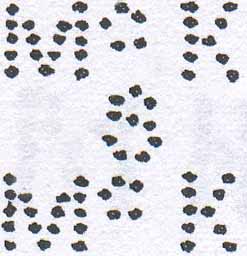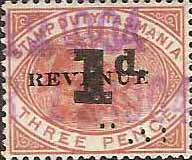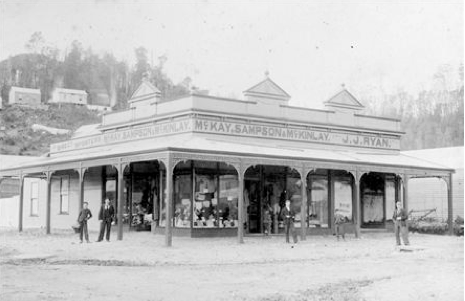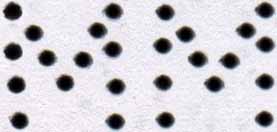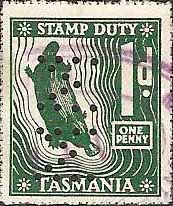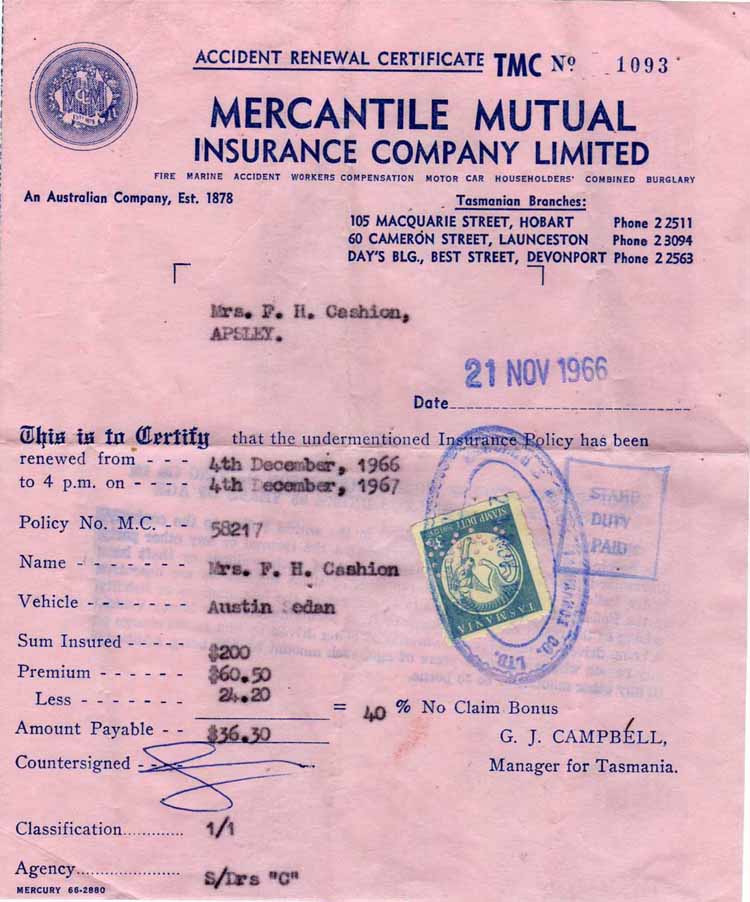|
Private Revenue Perfins of Tasmania An Elsmore Coath production The authors would welcome your comments additions or input into this work M -------------------------------------------------------- M&B.a
User: A D Meares & Bishop Stockbrokers Address: 33 Bligh St, Sydney, NSW. Revenue Use: Numeral: 1955 Series Roulette 3d, 2/6d, 5/-, 10/-, £1. Rarity Scale: Numeral: 1955 series 3d R4, 2/6 R4, 5/- R4, 10/- R4, £1 R4. Background: Alfred
Meares was born in Sydney in November 1904 and in
1926 he became a clerk at the Sydney Stock
Exchange. In 1932 he took a seat at the Sydney
Exchange and worked for a small group of private
clients.
After an absence for
military service in World War 2 he returned to his
seat and in 1949 he went into partnership with
Jesse Bishop as A D Meares and Bishop.
Jesse Bishop had been
born in Sydney in 1907 and was educated at Sydney
University but completed his studies at Cambridge
in England. Graduating in 1934 he worked for the
Imperial Smelting Corporation for a short period
before gaining a position with the stockbroking
firm W Thompson and Son. and later Dormer Rumball
and Co. in which he secured a partnership and a
seat on the London Stock Exchange in 1940.
As with his future
partner his career was punctuated by the war.
After the war he worked in the legal department at
Shell before returning to Australia for family
reasons in 1948.
In 1949 he joined the
Sydney Stock Exchange as a sole trader but soon
joined fellow sole trader Meares.
The partnership soon
moved from its small client base to become
involved in some major share floats including
Yates Seeds, Ampol Exploration, Canberra
Television, J B Young and Thomas Nationwide
Transport (TNT).
Bishop remained with
the firm until 1965 and Meares retired from his
role in the firm in 1970.
Device: The M&B
pattern is found on the revenue stamps of
Queensland, New South Wales, Victoria, Tasmania as
well as Western Australia. All of the strikes are
identical and Meares and Bishop are not known to
have had offices or seats on Stock Exchanges other
than in Sydney. Given this it is reasonable to
assume that the device was located in Sydney and
applied to revenue stamps of various States as
required to process transactions within the
jurisdiction of a given State revenue office. This
is supported by company stamps applied to
documents that all show the Bligh Street, Sydney
address.
Multiples of this
pattern show an inconsistent relationship to each
other so the device is most likely a single head
one. This is supported by the fact that the
strikes are identical which is less likely on a
multiple die device, which often show variation
between dies.
The M&B device is
only found on revenue stamps and the use on
documents shows that the stamps are punctured
prior to being affixed, indicating use as a
security device rather than a cancelling device.
The use as a security device to prevent theft is
further supported by the fact that once affixed
the stamps are then cancelled either by pen,
company cachet or circular punch.
The device was used
between 1962 and 1967.
Related Patterns:
Refer to other usage of this A D Meares and Bishop
device in:
NSW:
M&B.a
QLD:
M&B.a
TAS:
M&B.a
WA:
M&B.a -------------------------------------------------------- McK/S/McK.a
User: McKay Sampson & McKinlay (Later McKinlays Pty Ltd) Department Store Address: Brisbane St, Launceston, TAS. as well as Regional locations Revenue Use: Platypus Series: 1903 Series ('REVENUE' overprint) 1d, 2d. 1904 Series ('REVENUE' overprint) 1d on 3d, 2d. Numeral: 1904 Series 1d. Rarity Scale: Platypus Series: 1903 Series 1d R4, 2d R4. 1904 Series 1d on 3d R4, 2d R4. Numeral: 1904 Series 1d R4. Background: *1 *2 Gilbert McKinlay was born in Glasgow, Scotland in May 1851, and he moved with his family to Victoria arriving in August 1855 on the White Eagle. McKinlay worked in drapery businesses in Ballarat and Melbourne before coming to Launceston where he worked at Williamson & Thomas drapery in Brisbane Street. McKinlay later purchased the business and then in 1887 he joined with Robert McKay and Richard Sampson to form the company McKay, Sampson & McKinlay. McKay and Sampson had from 1886 traded in a drapery business as McKay, Sampson and Martin, also in Brisbane St, Launceston. This new business flourished and the company established branches around Tasmania. By 1900 they had branches in Devonport (1896), Queenstown, Gormanston and Mathinna, and an agent in London, all in addition to their Launceston head office. Later McKinlay’s son George joined the company and the in 1921 the company became a public company as McKinlay's Pty Ltd. George McKinlay died in July 1937 but the company was still linked to the family as Gilbert McKinlay's grandson, Gilbert, had joined the business in 1928. Gilbert remained with the company and was managing director when McKinlay’s last department store closed in 1984.
McKay, Sampson and McKinlay, Queenstown, Tasmania
Device: The McKSMcK.a pattern is quite a large one with 74 holes over 3 rows and is most suited to the large format Tasmanian Pictorials but it is also found on the smaller Sideface and Tablet issues as well as the smaller format revenues listed above.
It was a single head device and was most likely located at the Launceston head office as on postage stamps Launceston postmarks predominate. Early in its use it started to suffer damage to pins, initially in the M on the top row but in time this spread to other areas of sites in the pattern. Many examples that we have seen show partial and blind pins in addition to missing pins and sometimes the pattern is almost unreadable. The pattern is found on revenue and postage stamps of Tasmania over the period 1899 until at least 1908. Related Patterns: Nil *1 Trove *2 Tasmanian Government web site -------------------------------------------------------- MM.a
User: Mercantile Mutual Insurance Co Ltd General Insurance Provider
Address: 105 Macquarie St, Hobart, TAS. 60 Cameron St, Launceston, TAS. Day’s Building, Best St, Davenport, TAS. Revenue Use: 1920 Series Roulette (Plain) 1d, 6d, 2/6d, 5/-, 10/-(green). Last LSD Series 1d, 3d. 1966 3c. Rarity Scale: 1920 Series Roulette (Plain) 1d R4, 6d R3, 2/6d R4, 5/- R4, 10/-(green) R4. Last LSD Series 1d R4, 3d R4. 1966 3c R4. Background: *Mercantile Mutual was established in Sydney in 1878. The idea to establish a distinctly Australian insurance company had been discussed amongst a group of Sydney businessman in the previous year while they were attending the cricket match to decide the team to travel to England for the first Test series. The company grew quickly reflecting the booming Colonial economies of the time and they established offices initially in Sydney but later in Melbourne, Brisbane and Adelaide all in the first year of operation. In addition they sought and received many offers to provide agencies from Regional centres throughout New South Wales, Queensland and Victoria. The head office of the company was located in a series of offices in Pitt Street, Sydney, initially 177, then 168, 158 and 131, before the company purchased a property at 120 Pitt St, on which they built a purpose built office, occupying it from 1886. Growth was hampered by the hard economic times of the late 1880’s and 1890’s and this lead to some shrinking of the Melbourne and Brisbane offices and the closure of the Adelaide office, but by 1894 the company boasted of being the largest insurer in Sydney. The company resumed growth with the new century and expanded offices in Melbourne in 1901 and Brisbane in 1912 and established a branch in Hobart in 1918 with an office in Launceston and later in Davenport. The Brisbane office was initially at the corner of Queen and Eagle Sts but in 1926 they purchased and moved to premises at 62 Eagle St. The Sydney office had been relocated to 16 Martin Place before a new head office was established in 1929 at 117 Pitt St. In 1938 they established a branch in Perth replacing their agency, which had been established in 1920. Through the 1950s, 60s and 70s the company continued to grow with the acquisition of Oceanic Insurance, Australian General Insurance and Australian Metropolitan Life. In 1982 Mercantile Mutual became part of the ING Group when it acquired 50% of the company. In 1987 ING acquired 100% of Mercantile Mutual and the company changed its name to ING Australia in 2001. In 2002 ING Australia was partially acquired by the ANZ and in late 2009 ANZ acquired 100% of ING Australia. Device: This MM.a device was most likely located in the Hobart office as all the policy documents we have seen carrying the MM.a pattern are tied with company cachets from this office. The device was most likely a single head device and was certainly in use between 1959 and 1966 but may have been used over a slightly longer period. Previous studies have reported this pattern on postage stamps but we have not seen any evidence of this and these reports may be miss reports of other MM patterns. In fact at the time of the introduction of this device it may have been a company policy to not use perfins on postage stamps and only use the devices on revenues stamps. The multi head device used by Mercantile Mutual in their Sydney office is known used on revenue stamps until at least 1967, but use on postage stamps seems to have stopped around 1955. The matter is further confused by reports in previous studies of two separate MM patterns as having been used on Tasmanian revenues. This is not supported by the evidence we have found. Related Patterns: Refer to other Mercantile Mutual patterns in: NSW: MM.a MM.b MM.c MMICO.a MMICO.b VIC: MM.a MM.b MM.c *“Servant of a Century - The first 100 Years of the Mercantile Mutual Insurance” H. Mayfield (1978)
-------------------------------------------------------- © copyright 2011 |



